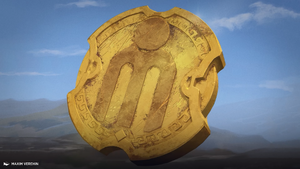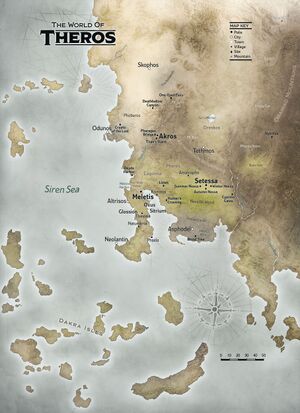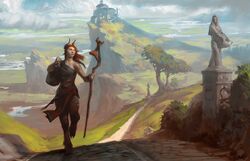Mortal Realm
| The Mortal Realm | |
|---|---|
| Information | |
| Plane | Theros |
The Mortal Realm is the main landscape of Theros, where the living mortals dwell. It is also referred to as the material plane. Theros's Mortal Realm is a sunlit world of the living comprising roughly 40,000 square miles of known territory on a larger, mostly unexplored continent.[1] It is bounded by the Siren Sea to the west and the Nistos Forest to the east,[2] and it is the only Therosian realm that can be directly entered or exited via planeswalking.[3]
Description
The Mortal Realm of Theros is comparatively small for a material world, with the known land spanning barely two hundred miles across and surrounded by untamed wilderness. Farther beyond lies the edge of the world, where the sea purportedly spills into the starry void. The central landscape includes a coastal region along the eastern Siren Sea, two interior mountain ranges, and the mysterious forested expanse east of those mountains. The north transitions into badlands and labyrinthine canyons inhabited by minotaurs. The sea itself is scattered with islands such as the Dakra Isles, which remain only partially charted.
Three main city-states, or "poleis," define human civilization on Theros: Meletis, Akros, and Setessa. Meletis dominates the southwestern peninsula; Akros guards the northern frontier; and Setessa lies near the northern border of the Nessian Wood. Other mortal groups also inhabit the land: the Lagonna and Pheres centaur bands roam between the poleis, leonin reside in the Oreskos valley, satyrs dwell near the Nessian Wood, and tritons inhabit coastal regions and parts of Meletis. Skophos, a city of minotaurs, lies farther north beyond Phoberos.
The necropoleis of Asphodel and Odunos house the Returned, undead beings who have escaped the underworld at the cost of their identities. These lands are blighted, reflecting the underworld's influence brought into the Mortal Realm.
Life in the Poleis
Each polis represents a distinct society built on political organization and adaptation to the land. Citizenship is restricted to those born to two citizen parents. Akros additionally requires military service for full civic status. All poleis have elected councils: Meletis is governed by the philosopher council known as the Twelve; Akros by a monarch advised by elected elders; and Setessa by a Ruling Council during the absence of its deific ruler, Karametra.
Trade between the poleis is regular. Caravans frequently travel between Meletis and Akros, exchanging goods like metalwork, fish, and textiles. Setessa trades more selectively, using barter over coinage and restricting market access to outsiders. The Lagonna centaurs trade plains goods and crafted items with Meletis and Setessa in exchange for tools and weapons.
Gymnasiums and theaters are key centers of recreation. These institutions support physical training, philosophical debate, and the arts. Theatrical performances and oral storytelling of epics such as The Theriad and The Callapheia are significant cultural events.
Meletian calendar
Although the method of marking years on Theros is unknown, Meletis has developed a calendar that has been at least partially adopted in the poleis of Akros and Setessa. The calendar is composed of 12 months, each beginning with the new moon, alternating between 30 and 29 days, and named after a festival celebrated during that month. Roughly every three years, an extra 30-day month is added to the end of the year, giving Theros a 364-day year on average, meaning its years may be the same length as on Earth.[4]
| Month | Length | Associated God | Observances |
|---|---|---|---|
| Lyokymion | 30 days | Thassa | Feast of the Melting Swell: Marks the start of a new year by celebrating the bounty of the sea. Observed through the first week of the year. |
| Protokynion | 29 days | Nylea | Festival of the First Hunt: Originally involved hunting, but is now a day of picnics, outdoor games, and frolicking to celebrate the full flowering of spring. |
| Astrapion | 30 days | Keranos | Lightning Festival: Intricate sand paintings are created and washed away by the first storm of the summer. Celebrates the impermanence of knowledge and the power of change. |
| Polidrysion | 29 days | Ephara | Celebration of the founding of Meletis: Celebrated within the city-state and among Ephara's followers. |
| Thriambion (Meletis) Iroagonion (Akros) |
30 days | Iroas | Thriambion: Commemoration of the Meletian conquest of Natumbria. Celebrates the city-state's unification of the peninsula.
Iroan Games: A Series of athletic competitions. |
| Megasphagion | 29 days | Mogis | Revel in Ruin: Domesticated version of Mogis's typical rites involving the sacrifice, cooking, and eating of cattle. Often devolves into a drunken and occasionally violent revel. |
| Chalcanapsion | 30 days | Purphoros | The Kindling or Forge-Lighting: Worshipers keep a bonfire burning from sundown to sunrise, acknowledging that Purphoros warms the earth. |
| Necrologion | 29 days | Athreos | Feast of the Necrologion: Pious souls silently spend the day reading ancient memoirs or writing messages for their descendants. |
| Therimakarion | 30 days | Karametra | Blessing of the Beasts: Celebrates humans' partnership with domesticated animals. Work animals are given a day of rest, while strays found on this day are considered lucky. |
| Katabasion | 29 days | Erebos | The Descent: Ceremony in which worshipers make a symbolic journey to the Underworld by entering a cave, offering prayers and sacrifices to Erebos in complete darkness, and slowly returning to the surface just before sunrise. |
| Cheimazion | 30 days | Pharika | Day of Affliction: Pharika's winter festival. The sick and infirm sleep in the god's temples during the festival in hopes of receiving a miraculous cure, and the truly devout imbibe near-lethal doses of poison, trusting Pharika to oversee their recovery. Observed during the first week of the month. |
| Agrypnion | 29 days | Kruphix | The Watching: Marks the end of winter and the close of the year. |
| Anagrypnion | 30 days | Kruphix | Occurs once every three years. |
The largest holiday aligned with Heliod was the summer solstice, celebrated with three days of ceremonious feasting, weddings, and oaths of loyalty.[5][4] It is unclear which month this holiday would have occurred in, likely between Astrapion and Megasphagion, and whether this holiday is still celebrated after Heliod's death is unknown.
Meletian officials also designate two holidays during the year, making allowances for the overlap with certain centaur celebrations.[6]
Lunar observances
New Moon
The most sacred rituals to Phenax are performed at night under a new moon. Offerings of stolen goods, written lies, and loaded dice are thrown into crags or buried at crossroads and claimed by the god or his servants.
Crescent Moon
A waxing crescent, usually in the first week of each month, is a sacred time for followers of Pharika and is considered a favorable time to harvest medicinal plants. The crescent moon is also the symbol of Athreos.
Full Moon
Annually on the day of the first full moon after the autumnal equinox, leonin prides gather at Tethmos to celebrate, renew friendships, and select a new zibnyth, or Speaker, to reign for the following year.
During the week of each full moon, the usually isolationist polis of Setessa allows visitors to enter and participate in the Abora Market, a massive, open-air market within the city.
On the evening of each full moon, followers of Karametra host feasts in celebration of parenthood and community.[4] New parents are given gifts and blessings, while young couples travel into the woods together.
Lunar Eclipse
The blood moon is seen to represent Mogis's eye and is considered the holiest occasion by his followers.[4] It is generally celebrated by consuming meat, often raw, with intoxicants, and performing ritualistic scarification.
Economy

Trade between Meletis and Akros is constant and productive.[4] Caravans make the two-day journey between the poleis at least once a week, carrying fine Akroan metalwork and pottery to Meletis, and Meletian fabric, stonework, and fish northward. Both poleis mint coins of copper, silver, and gold, with equivalent value. Setessa trades with the other poleis as well, but less extensively. Abora Market, just inside the city gates, is open to outsiders only on certain days, and Setessan merchants prefer to barter goods rather than accept currency. Despite these restrictions, Setessan food, woodwork, and trained falcons are highly valued in the other poleis.
Aside from the other human poleis, Meletis and Setessa both trade with the centaurs of the Lagonna band.[4] The centaurs don't work metal, so they trade woodwork, the produce of the plains, and woven blankets to the human poleis in exchange for weapons and armor.
Locations within the Mortal Realm
See each region entry for more specific locations.

- The Chaparral
- a dense growth of shrubs and small trees on the eastern border of Theros, south of the Oraniads and north of the Nistos Forest.
- Skola Vale
- a verdant and enchanted valley dotted with copses of trees and occupied by satyrs. [4][7]
- Skola Vale
- The Katachthon Mountains
- a perilous volcanic range east of Akros, marked by restless volcanoes, jagged peaks, and ancient magic older than the gods themselves. Treacherous storms, shifting terrain, and powerful magical forces make travel nearly impossible outside the few known passes, while dragons and mythic forges hidden deep within the mountains speak to the range's dangerous and mysterious nature.[4]
- Akros
- a rugged and perilous highland territory stretching across the Katachthon Mountains, where sheer cliffs, volcanic ridges, and monster-haunted passes dominate the landscape. Scattered farming communities cling to narrow valleys and plateaus, surrounded by stratian outposts and shrines atop windswept peaks. It is a harsh but sacred land, believed to bring mortals closer to Nyx, and steeped in martial tradition, divine reverence, and the ceaseless vigilance of its warrior people.[4]
- Akros
- Meletis
- a gleaming coastal city renowned for its towering temples, elite magical academy, and the philosophical ideals that guide its governance. Founded in defiance of tyranny, it remains a haven for scholars, mages, and visionaries devoted to reason, learning, and civic virtue. The polis's council, the Twelve, governs through debate and contemplation, striving to uphold justice through wisdom rather than brute power.[8][9][10]
- Nessian Wood
- an ancient, sprawling forest in southern Theros, known for its untamed wilderness and magical denizens, far removed from the reach of most human civilization. It is sacred to the god Nylea, who allows only limited hunting within its bounds and punishes intruders or poachers who defy her will. Its gnarled, towering trees are believed to drink from the Underworld's Tartyx River, and the wood teems with both natural beasts and supernatural creatures such as hydras, dryads, satyrs, and centaurs.[4]
- Setessa
- a sprawling polis nestled within the vast Nessian Wood, a dense and ancient forest revered as the domain of the huntress deity Nylea. Setessa's inhabitants live in harmony with the wild, training with animals like falcons and wolves to protect their home from threats. The city's layout resembles the rings of a tree, with natural defenses formed by the surrounding forest, emphasizing a close bond between civilization and nature.[8][6][7]
- Setessa
- The Nistos Forest
- a large and uncharted forest east of the Sperche River.
- The Oraniad Mountains
- a towering volcanic range along the eastern edge of Oreskos, revered as the closest point on Theros to the divine realm of Nyx. Shrouded in mystery and supernatural phenomena, the Oraniads are home to sacred shrines, dangerous volcanoes, and ancient secrets that lure pilgrims and doom reckless explorers.[4]
- Oreskos
- grasslands in the rocky river valley in a remote eastern region of Theros, surrounded by both the Oraniads and the Katachthons, and sharing a border with the Nessian Wood. It is the home of the iconoclastic leonin, and the gods are said to have no sway here.[4]
- Phoberos
- a harsh, desolate badlands region on Theros, inhabited primarily by savage outcast minotaur raiders and haunted by undead remnants of volcanic devastation. It serves as a brutal, contested borderland between the city-states of Akros and Skophos, marked by treacherous canyons, ancient ruins, and constant conflict between marauders and Akroan soldiers. Alongside its infamous minotaur bands, the region is home to dangerous monsters and war-torn frontier camps, where vigilant stratian patrols defend against ever-present threats.[4].[6]
- Realms of the Returned
- cities of the dead, or necropoleis, where those who have escaped the Underworld via the Path of Phenax gather in exile from the living world they no longer remember. Stripped of their identities and feared by mortals, the Returned drift toward these bleak sanctuaries to exist in uneasy detachment, shaped by habit, emotion, and fragments of a forgotten past.[4]
- Asphodel
- a necropolis of the Returned on, located on a lifeless peninsula known as the Despair Lands, south of the Nessian Wood. Shaped by the Underworld's influence, it is a city of crumbling ruins and dusty streets where the hollow-eyed dead dwell in isolation, disturbed only by passing emotions or faded memories. A grim parody of the cities they fled in death, Asphodel is ruled by the silent Aphonai and defended by the Order of Phaios, with its people trading in funerary clay and worshiping Phenax and Athreos.[13][4]
- Odunos
- a city of the Returned who despise the living and take cruel delight in destroying all they once valued. Ruled by Tymaret, the Murder King, the city teems with violent undead gangs and sends out raiding parties across Theros in service of Erebos and the relentless hunt for the trickster god Phenax.
- Asphodel
- Siren Sea
, also called the Great Sea[14], a vast, ever-changing ocean that borders western Theros and stretches into the mythic unknown. It is ruled by the sea god Thassa, teeming with divine enchantments, monstrous beasts, elusive islands, and the hidden cities of the tritons. [15]
- Skophos
- the labyrinthine city-state of the minotaurs, built from the red sandstone badlands and known for its twisting maze-like streets that protect its inhabitants and confuse outsiders. Governed by priests and warlord tyrants devoted to Mogis, the city's fractious rulers rarely unite except when compelled by Mogis's priests to face common threats. Originally born from the conflict between the gods Iroas and Mogis, Skophos stands as a symbol of raw power and savagery in opposition to the honor-bound polis of Akros.[4]
- The Sperche River
- The longest river of Theros, running from the mountains north of Oreskos, south along the Oreskos Road and through the Nessian Wood and into the Siren Sea.[16] [4]
In-game references
- Referred to:
References
- ↑ J.R. Zambrano (May 28, 2020). "D&D: Massive New Mythic Odysseys Of Theros Rules". Belloflostsouls.com.
- ↑ Jenna Helland (May 2014) - Journey into Nyx: Godsend, Part II, Wizards of the Coast. ISBN: 978-0-7869-6567-0.
- ↑ Doug Beyer (June 01, 2014). "So is Elspeth less dead on Theros than she would be on any other plane?". A Voice for Vorthos. Tumblr.
- ↑ a b c d e f g h i j k l m n o p q Wizards RPG Team (2020), D&D Mythic Odysseys of Theros, Wizards of the Coast
- ↑ (2013). Theros Player's Guide. Wizards of the Coast.
- ↑ a b c The Magic Creative Team (August 28, 2013). "Planeswalker's Guide to Theros, Part 2". magicthegathering.com. Wizards of the Coast.
- ↑ a b Jenna Helland (2014) - Theros: Godsend, Part I, WotC.
- ↑ a b Doug Beyer (August 28, 2013). "Are Akros, Setessa and Meletis all associated with specific colours?". A Voice for Vorthos. Tumblr.
- ↑ Theros: Godsend, Part I, Chapter 10
- ↑ Mike McArtor (February 20, 2014). "That's the Spirits!". magicthegathering.com. Wizards of the Coast. Archived from the original on 2021-04-29.
- ↑ Flavor text of Nyxborn Seaguard
- ↑ File:Mythic Odysseys of Theros map.jpg
- ↑ The Magic Creative Team (September 04, 2013). "Planeswalker's Guide to Theros, Part 3". magicthegathering.com. Wizards of the Coast.
- ↑ Jenna Helland (2014) - Theros: Godsend, Part I, WotC, Prologue.
- ↑ K. Arsenault Rivera (March 28, 2023). "March of the Machine - Episode 9: The Old Sins of New Phyrexia". magicthegathering.com. Wizards of the Coast.
- ↑ Journey into Nyx: Godsend, Part II, Chapter 10
